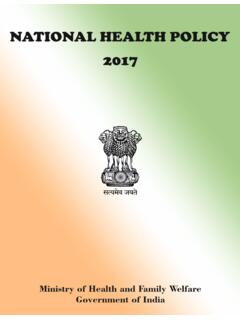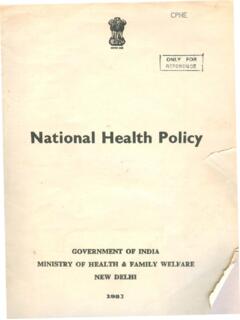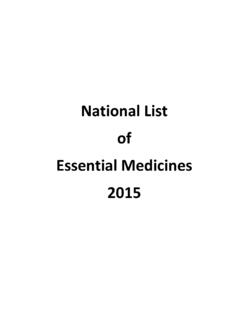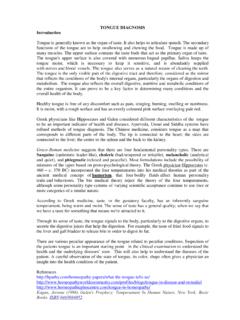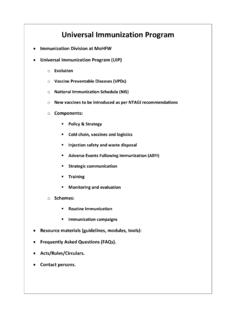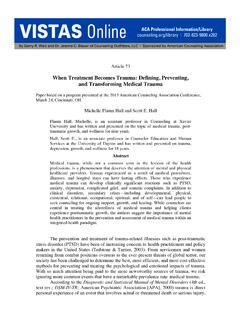Transcription of Universal Immunization Program - NHP
1 Universal Immunization Program Immunization Division at MoHFW Universal Immunization Program (UIP) o Evolution o Vaccine Preventable Diseases (VPDs) o National Immunization Schedule (NIS) o Components: Policy & Strategy Cold chain, vaccines and logistics Injection safety and waste disposal Adverse Events Following Immunization (AEFI) Strategic communication Training Monitoring and evaluation o Schemes: Routine Immunization Immunization campaigns Resource materials (guidelines, modules, tools): Frequently Asked Questions (FAQs). Acts/Rules/Circulars. Contact persons. Immunization Division at MoHFW Immunization division is a part of the RCH Program under National Rural Health Mission (NRHM) and is placed in the Ministry Of Health and Family Welfare, Nirman Bhawan New Delhi. This division provides all the technical assistance required to undertake the activities under UIP.
2 The division reviews the state Program implementation plans and facilitates in its approval process as per norms and guidelines The key roles of this division include activities related to Routine Immunization , Campaigns (SIAs) such as Polio, Measles, and Japanese Encephalitis, Monitoring Adverse Events Following Immunization (AEFI), Vaccine and Cold Chain Logistics, Strategic communication related to Immunization Program and trainings related to Immunization Program . It facilitates the National Technical Advisory Group on Immunization (NTAGI) to review and recommend its views on various technical and programmatic issues related to Immunization such as new vaccine introduction etc. The division is engaged in reviewing and sharing the learnings of the Program with state and district Program officers.
3 The division also works closely with all development partners and other stake holders. Organogram of Immunization Division: Universal Immunization Programme (UIP) Evolution of the programme: 1978: Expanded Programme of Immunization (EPI). Limited reach - mostly urban 1985: Universal Immunization Programme (UIP). For reduction of mortality and morbidity due to 6 VPD s. Indigenous vaccine production capacity enhanced Cold chain established Phased implementation - all districts covered by 1989-90. Monitoring and evaluation system implemented 1986: Technology Mission On Immunization Monitoring under PMO s 20 point programme Coverage in infants (0 12 months) monitored 1992: Child Survival and Safe Motherhood (CSSM) Included both UIP and Safe motherhood Program 1997: Reproductive Child Health (RCH 1) 2005: National Rural Health Mission (NRHM) Vaccines under UIP Under UIP, following vaccines are provided: 1.
4 BCG (Bacillus Calmette Guerin) 2. DPT (Diphtheria, Pertussis and Tetanus Toxoid) 3. OPV (Oral Polio Vaccine) 4. Measles 5. Hepatitis B 6. TT (Tetanus Toxoid) 7. JE vaccination (in selected high disease burden districts) 8. Hib containing Pentavalent vaccine (DPT+HepB+Hib) (In selected States) Diseases Protected by Vaccination under UIP 1. Diphtheria 2. Pertussis. 3. Tetanus 4. Polio 5. Tuberculosis 6. Measles 7. Hepatitis B 8. Japanese Encephalitis ( commonly known as brain fever) 9. Meningitis and Pneumonia caused by Haemophilus Influenzae type b VPD surveillance Vaccine Preventable Diseases (VPD) surveillance system is needed to create evidence base to enable planning and deployment of effective interventions. India has different surveillance models. Integrated Disease surveillance Project (IDSP) is one of those surveillance systems. IDSP is a case-based surveillance system for detection of early warning signals of outbreaks.
5 There are other sentinel surveillance systems which falls under different vertical national health programs for diseases targeted for control, elimination or eradication. Another source is the National Polio surveillance Project (NPSP), which has done extremely well in acute flaccid paralysis (AFP) and measles surveillance in India. WHO/NPSP provides needed technical and training support for AFP and measles surveillance . National Immunization Schedule (NIS) Under UIP, GoI is providing vaccination to prevent seven vaccine preventable diseases, Diphtheria, Pertussis, Tetanus, Polio, Measles, Hepatitis B & Tuberculosis. S No Vaccine& its presentation Protection Route Number of doses Vaccination Schedule 1 BCG (Bacillus Calmette Guerin)- Lyophilized vaccine Tuberculosis Intra- dermal 1 at birth (upto 1 year if not given earlier) 2 OPV (Oral Polio Vaccine)- Liquid vaccine Poliomyelitis Oral 5 Birth dose for institutional deliveries, Primary three doses at 6, 10 & 14 week and one booster dose at 16-24 month of age.
6 Given orally 3 Hepatitis B Liquid Vaccine Hepatitis B Intra-muscular 4 Birth dose (within 24 hours) for institutional deliveries, Primary three doses at 6, 10 & 14 week. 4 DPT (Diphtheria, Pertussis and Tetanus Toxoid) Liquid vaccine Diphtheria, Pertussis and Tetanus Intra-muscular 5 Three doses at 6, 10 & 14 week and two booster dose at 16-24 month and 5-6 years of age 5 Measles - Lyophilized vaccine Measles Sub- cutaneous 2 9-12 months of age and 2nd dose at 16-24 months. 6 TT (Tetanus Toxoid) Liquid vaccine Tetanus Intra-muscular 2 2 10 years and 16 years of age For pregnant woman, two doses given(one dose if previously vaccinated within 3 Year) 7 JE vaccination (in selected high disease burden districts) Lyophilized vaccine Japanese Encephalitis (Brain fever) Sub- cutaneous 2 9-12 months of age and 2nd dose at 16-24 months (6 month after vaccination drive) 8 Hib (given as pentavalent containing Hib Pneumonia and Hib Intra-muscular 3 6, 10 & 14 week of age In addition, JE vaccination is provided in 113 districts and additional 62 new JE endemic districts have been identified.)
7 JE second dose has been introduced under UIP in these endemic districts from April,13 Pentavalent vaccine introduced in 8 states Tamil Nadu, Kerala, Haryana, J&K, Gujarat, Karnataka, Goa and Puducherry. Hib+DPT+Hep B) (in 8 states) Liquid vaccine meningitis Implementation of Routine Immunization RI targets to vaccinate 26 million new born each year with all primary doses and ~100 million children of 1-5 year age with booster doses of UIP vaccines. In addition, 30 million pregnant mothers are targeted for TT vaccination each year. To vaccinate this cohort of 156 million beneficiaries, ~9 million Immunization sessions are conducted, majority of these are at village level. As per Coverage Evaluation Survey (2009), of vaccination in India is provided through Public sector (53% from outreach session held at Anganwadi centre ( ), sub centre ( ) etc.
8 While private sector contributed to only ASHA and AWW support ANM by mobilizing eligible children to session site thus try to ensure that no child is missed. ASHA is also provided an incentive of Rs. 150/session for this activity To ensure potent and safe vaccines are delivered to children, a network of ~27,000 cold chain points have been created across the country where vaccines are stored at recommended temperatures. Components: I. Strategy and policy: National Health Policy (2002) is directed towards achieving an acceptable, affordable and sustainable standard of health through an appropriate health system. Provision of Universal Immunization of children against vaccine preventable diseases is one of the major goals under this policy. Country s five year plan also puts emphasis on reduction in maternal and infant mortality rates as major maternal and child health indicators.
9 Country developed a comprehensive Multi Year Strategic Plan for Immunization in 2005 with an addendum in 2010 to achieve these targets of improving access and utilization of Immunization in the country. This document is a national strategy document to guide development of UIP plans at national and state levels. Currently development of next multi year plan is under process. Ministry of Health and Family Welfare also revised the National Vaccine Policy in 2011. The goal of this vaccine policy is to guide decision making in order to develop a long term plan to strengthen the UIP. This policy addresses issues of vaccine security, management, regulation guidelines, vaccine research and development and product development. To ensure informed decision making for any modification in UIP schedule or inclusion of new vaccines, there is a National Technical Advisory Group on Immunization (NTAGI) which comprises of a number of technical experts, national Program leaders and managers, representatives from development partners and professional bodies.
10 All issues related to the Program and vaccines are presented to this group for review and discussions and final recommendations. II. Cold Chain System, Vaccines and Logistics: Cold Chain is a system of storing and transporting vaccine at the recommended temperature range from the point of manufacture to point of use. India has built a vast cold chain infrastructure to ensure that only potent and effective vaccines reach millions of beneficiaries across the country. The vaccines are supplied by manufacturers directly to four Government medical Store Depots (at Karnal, Mumbai, Chennai and Kolkata) and state and regional vaccine stores. The GMSDs supply to the states and regional vaccine stores; state and regional vaccine stores supply vaccines to Divisional vaccine stores and district. The vaccines are further supplied to last cold chain points which are usually situated in Primary Health Centers (PHCs) and Community Health Centers.

